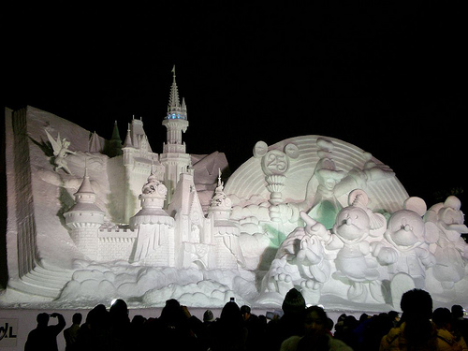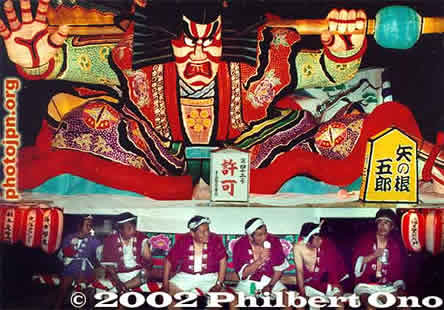Festivals
Japanese festivals are traditional festive occasions. Some festivals have their roots in Chinese festivals but have undergone dramatic changes as they mixed with local customs.
Some are so different that they do not even remotely resemble the original festival despite sharing the same name and date. There are also various local festivals (e.g. Tobata Gion) that are mostly unknown outside a given prefecture. It is commonly said that you will always find a festival somewhere in Japan.
Unlike most people of East Asian descent, Japanese people generally do not celebrate Chinese New Year (it having been supplanted by the Western New Year's Day in the late 19th century); although Chinese residents in Japan still do. In Yokohama Chinatown, Japan's biggest Chinatown, tourists from all over Japan come to enjoy the festival. And similarly the Nagasaki Lantern Festival is based in Nagasaki's Chinatown.
Matsuri is the Japanese word for a festival or holiday. In Japan, festivals are usually sponsored by a local shrine or temple, though they can be secular.
There is no specific matsuri days for all of Japan; dates vary from area to area, and even within a specific area, but festival days do tend to cluster around traditional holidays such as Setsubun or Obon. Almost every locale has at least one matsuri in late summer/early autumn, usually related to the rice harvest.
Notable matsuri often feature processions which may include elaborate floats. Preparation for these processions is usually organized at the level of neighbourhoods, or machi.
One can always find in the vicinity of a matsuri booths selling souvenirs and food such as takoyaki, and games, such as Goldfish scooping. Karaoke contests, sumo matches, and other forms of entertainment are often organized in conjunction with matsuri. If the festival is next to a lake, renting a boat is also an attraction.
Some examples of local festivals are:
· Sapporo Snow Festival (Hokkaido)
Sapporo Yuki Matsuri is one of the largest festivals of the year for the city of Sapporo. This festival is held in February for one week. This festival began in 1950 when high school students built snow statues in Odori Park, central Sapporo. This event is now very large and commercialized. This event attracts over two million people from around the world every year. About a dozen large sculptures are built for the festival along with around 100 smaller snow and ice sculptures. Several concerts and other events are held at this festival.
· Lake Shikotsu Ice Festival
Lake Shikotsu is the northernmost ice-free lake which is 363 meters deep. This festival features a moss-covered cave, which has evergreen draped on the inside and is covered in ice (Gianola, 2008). This festival is held from late January to mid February. This festival features ice sculptures, small and large. At night the sculptures are illuminated by different colored lights. There is a fireworks show during the festival as well. Admission is free.
· Lake Towada Snow Festival
This lake festival is held in the beginning of February. Held in the town of Yasumiya, this festival is on the south side of lake Towada (near the wooden statues). This festival is open all day, but at 5pm one can enjoy activities such as going through a snow maze, exploring a Japanese igloo, and eat foods from Aomori and Akita prefectures. There is a fireworks show and events held on an ice stage.
· Aomori Nebuta Festival
This festival is held annually and features colorful lantern floats called nebuta which are pulled through the streets of Central Aomori. This festival is held from about the 2nd-7th Augusts every year. This event attracts millions of visitors. During this festival, 20 large nebuta floats are paraded through the streets near Aormori JR rail station. These floats are constructed of wooden bases and metal frames. Japanese papers; washi, are painted onto the frames. These amazing floats are finished off with the historical figures or kabuki being painted on the paper. These floats can take up to a year to complete. There is a dance portion of this festival. There are haneto dancers and they wear special costumes for this dance
· Nango Summer Jazz Festival
This event is held every year. Thousands of artists from all over Tohoku and even further regions come to Nango to perform. This is the largest open-air jazz concert held in Tohoku region. This festival began in 1989, in a small venue indoors. There was such a large response from the fans that was expanded into a large annual festival. One must purchase tickets for this event.
· Cherry blossom festivals
Japan celebrates the entire season of the cherry blossoms. All over Japan festivals are held and include food and at night beautiful lanterns.
Examples of nationwide festivals:
· New Year ( Shogatsu )
Date: 1–3 of January
New Year observances are the most important and elaborate of Japan's annual events. Before the New Year, homes are cleaned, debts are paid off, and osechi (food in lacquered trays for the New Year) is prepared or bought. Osechi foods are traditional foods which are chosen for their lucky colors, shapes, or lucky-sounding names in hopes of obtaining good luck in various areas of life during the New Year. Homes are decorated and the holidays are celebrated by family gatherings, visits to temples or shrines, and formal calls on relatives and friends. The first day of the year (ganjitsu) is usually spent with members of the family.
· Doll Festival
Date: March 3
This is the day families pray for the happiness and prosperity of their girls and to help ensure that they grow up healthy and beautiful. The celebration takes place both inside the home and at the seashore. Both parts are meant to ward off evil spirits from girls. Young girls put on their best kimonos and visit their friends' homes.
Tiered platforms for hina ningyō (hina dolls; a set of dolls representing the emperor, empress, attendants, and musicians in ancient court dress) are set up in the home, and the family celebrates with a special meal of hishimochi (diamond-shaped rice cakes) and shirozake (rice malt with sake).
· Hanami
Date: April
Various flower festivals are held at Shinto shrines during the month of April. Excursions and picnics for enjoying flowers, particularly cherry blossoms are also common. In some places flower viewing parties are held on traditionally fixed dates. This is one of the most popular events during spring. The subject of flower viewing has long held an important place in literature, dance and the fine arts.
Ikebana (flower arrangement) is also a popular part of Japanese culture and is still practiced by many people today. Some main things people do during this event are: games, folk songs, folk dance, flower displays, rides, parades, concerts, kimono shows, booths with food and other things, beauty pageant, and religious ceremonies. Families go out during weekends to see the cherry blossoms.
· "7-5-3" Festival
Date: November 15
Information: Five-year-old boys and seven- or three-year-old girls are taken to the local shrine to pray for their safe and healthy future. This festival started because of the belief that children of certain ages were especially prone to bad luck and hence in need of divine protection. Children are usually dressed in traditional clothing for the occasion and after visiting the shrine many people buy chitose-ame ("thousand-year candy") sold at the shrine.
Sources :
http://en.wikipedia.org/wiki/Japanese_festivals
http://www.jaunted.com/files/3873/Gion_Matsuri_Float.jpg
http://www.pinktentacle.com/images/yuki_matsuri_8.jpg
http://www.photojpn.org/matsuri/tohoku/images/nebu1.jpg
http://www.misawa.af.mil/shared/media/photodb/web/070711-F-9322E-001.JPG
http://theflowershowblog.files.wordpress.com/2010/02/400px-2008-subaru-cherry-blossom-festival-of-greater-philadelphia-1.jpg
http://bradyoshiro.com/blog/wp-content/uploads/2009/03/hina_matsuri_display.jpg
http://www.bornplaydie.com/japan/travel/kyoto/maruyama-hanami.jpg
http://web-japan.org/nipponia/nipponia34/images/feature/27_01.jpg








No comments:
Post a Comment